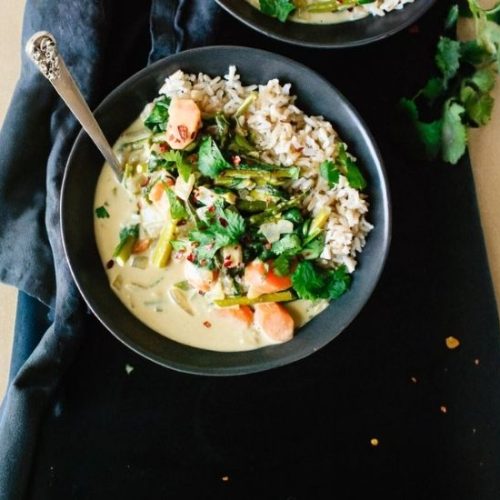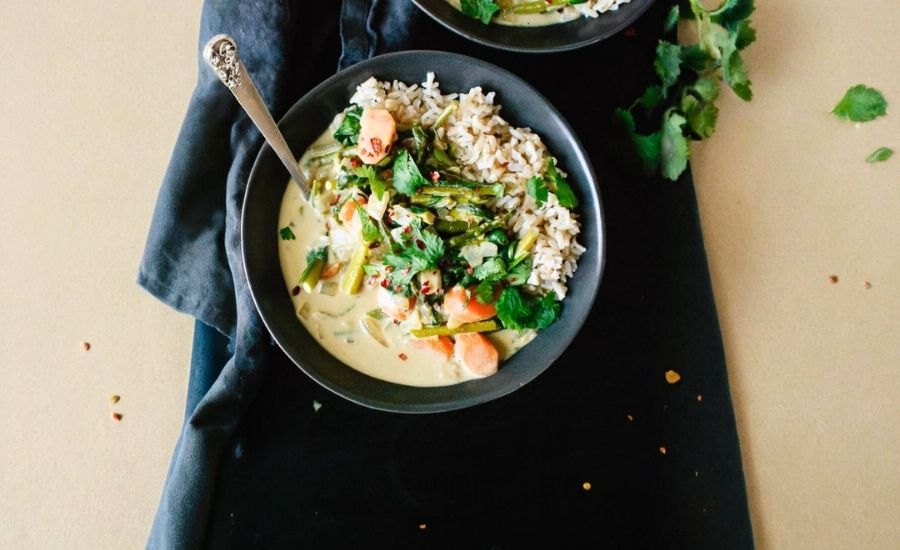All products are selected by our editorial team for quality. If you buy through our links, we may earn a small commission at no extra cost to you.
This Thai Green Curry with Spring Vegetables is a standout dish for its vibrant combination of fresh, seasonal produce and rich, aromatic flavors from the green curry paste and coconut milk.
It’s a nourishing vegetarian meal packed with fiber-rich vegetables like asparagus, carrots, and spinach, which contribute essential vitamins and minerals.
The inclusion of brown basmati rice provides a whole grain base high in fiber and complex carbohydrates, making this dish both satisfying and balanced.
With a moderate protein content from plant-based ingredients, this curry offers a healthy option for those seeking a flavorful, low-cholesterol meal.
The recipe’s use of coconut oil and full-fat coconut milk delivers good fats that support brain health and provide long-lasting energy without saturated fat overload.
Plus, the recipe is perfect for everyday cooking: it’s straightforward to prepare, comes together in under an hour, and lends itself well to meal prep and reheating.
This curry is equally great for weeknight dinners or a nourishing lunch that feels indulgent yet wholesome.
Must-Have Tools for Perfect Results
Large Deep Skillet or Sauté Pan
Ideal for cooking the curry evenly without spills. Its deep sides accommodate stirring liquids and vegetables comfortably. This versatile pan is great for sautés, stir-fries, and one-pot meals, making it a kitchen staple.
Medium Saucepot
Essential for boiling and resting the brown basmati rice properly. A sturdy saucepot with a tight-fitting lid helps retain steam and ensures fluffy, perfectly cooked rice every time.
Sharp Chef’s Knife
Used for dicing onions, chopping ginger, slicing asparagus, and cutting carrots with precision. A reliable chef’s knife makes prep faster, safer, and more enjoyable, suitable for all your chopping needs.
Measuring Spoons
Accurate measurement of curry paste, sugar, soy sauce, and spices ensures balanced flavor every time. Durable measuring spoons are indispensable for consistent cooking and baking results.
Wooden or Silicone Spoon
Perfect for stirring the curry mixture gently without scratching cookware surfaces. These spoons withstand heat and are easy to clean, useful for mixing and serving a wide range of dishes.

Thai Green Curry with Vegetables
Equipment
- 1 large deep skillet or sauté pan
- 1 medium saucepot (for rice)
- 1 Sharp Chef’s Knife
- Measuring Spoons (set)
- 1 wooden or silicone spoon
Ingredients
- 1 cup brown basmati rice rinsed well
- 2 teaspoons coconut oil or olive oil
- 1 small white onion finely diced
- 1 tablespoon fresh ginger peeled and minced
- 2 garlic cloves minced
- Pinch of salt
- ½ bunch asparagus trimmed and cut into 2-inch pieces (about 2 cups)
- 3 medium carrots peeled and sliced diagonally into ¼-inch rounds (about 1 cup)
- 2 tablespoons Thai green curry paste ensure vegetarian-friendly
- 1 14-ounce can full-fat coconut milk
- ½ cup water
- 1 ½ teaspoons coconut sugar or raw brown sugar
- 2 packed cups baby spinach roughly chopped
- 1 ½ teaspoons rice vinegar or freshly squeezed lime juice
- 1 ½ teaspoons soy sauce or tamari use gluten-free tamari if preferred
- Fresh cilantro chopped (for garnish)
- Red pepper flakes optional, for heat
Instructions
- Prepare the Brown Basmati Rice: Bring a large pot of water to a rolling boil. Add the rinsed brown basmati rice and let it cook uncovered for approximately 30 minutes, stirring occasionally to prevent sticking. Once tender, drain the rice thoroughly in a fine-mesh sieve. Return it to the pot, cover with the lid, and let it steam off the heat for at least 10 minutes. This resting step helps the rice finish cooking and become fluffy.
- Sauté Aromatics and Vegetables: Heat the coconut or olive oil in a large, deep skillet over medium heat. Add the diced onion, minced ginger, and garlic, along with a pinch of salt. Stir frequently, cooking until the onion softens and the mixture becomes fragrant—about 5 minutes. Next, toss in the asparagus and carrots, stirring occasionally, and cook for an additional 3 minutes to begin tenderizing the vegetables.
- Build the Curry Base: Add the Thai green curry paste to the skillet. Stir constantly for about 2 minutes to toast the paste lightly, enhancing its flavor and aroma. Pour in the coconut milk along with ½ cup of water and the coconut sugar. Stir well to combine and bring the mixture to a gentle simmer.
- Simmer Vegetables to Tenderness: Reduce the heat as needed to maintain a gentle simmer. Let the curry cook uncovered for 5 to 10 minutes, or until the carrots and asparagus are tender but still vibrant. Stir occasionally to prevent sticking and to blend flavors.
- Add Spinach and Final Seasoning: Stir in the chopped baby spinach and cook for about 30 seconds, just until it wilts. Remove the skillet from the heat, then season the curry with rice vinegar (or lime juice) and soy sauce to brighten the flavors. Adjust salt and add red pepper flakes if you prefer a bit of spice.
- Serve and Garnish: Spoon the steamed brown basmati rice into bowls and ladle the hot green curry over the top. Garnish generously with fresh cilantro and an extra sprinkle of red pepper flakes, if desired. Serve immediately and enjoy!
Notes
- Green Curry Paste: Choose a vegetarian-certified Thai green curry paste. Brands like Thai Kitchen usually fit this, but always double-check ingredients.
- Vegetable Substitutions: If asparagus is out of season, sliced snow peas make a fresh and crisp alternative. Feel free to add other spring vegetables as well.
- Gluten-Free Option: Use gluten-free tamari instead of soy sauce to keep this dish suitable for gluten-sensitive diets.
- Coconut Milk: For a lighter curry, use light coconut milk; for a richer texture, stick with full-fat.
- Rice Cooking Tip: If you prefer, you can cook the brown basmati rice in a rice cooker or Instant Pot for convenience and perfectly fluffy results.
- Storage: Store leftovers in an airtight container in the fridge for up to 3 days. Reheat gently on the stove or in a microwave, adding a splash of water or coconut milk to loosen the curry if it thickens.
Chef’s Secrets for Flavorful Curry
To get the most vibrant and authentic flavor in this Thai green curry, start by gently toasting the green curry paste in the hot oil.
This simple step helps release its essential oils and deepens the aroma, creating a rich foundation for the dish.
Use fresh ginger and garlic rather than pre-minced varieties for a brighter, more complex flavor.
When cooking the rice, rinsing it well and allowing it to rest covered after boiling helps achieve fluffy, separate grains instead of sticky clumps.
Feel free to adjust the balance of tangy rice vinegar or lime juice and salty soy sauce at the end to suit your palate — this finishing touch brightens the curry and harmonizes all the flavors beautifully.
Serving Suggestions to Elevate Meals
This green curry pairs wonderfully with fluffy brown basmati rice, which soaks up the luscious sauce perfectly.
For an extra touch, serve it alongside a simple cucumber salad or fresh spring rolls to add crisp textures and cool contrasts.
Garnishing with fresh cilantro and a sprinkle of red pepper flakes not only enhances presentation but adds layers of fresh, herbal, and spicy notes.
Leftover curry can also be transformed into a hearty soup by thinning with vegetable broth and adding noodles or tofu for extra protein.
Whether served as a solo vegetarian main or part of a broader Thai-inspired meal, this curry’s vibrant flavors shine in any context.
Storage Tips to Maintain Freshness
Store any leftover green curry in an airtight container in the refrigerator for up to three days.
The flavors often deepen and meld overnight, making reheated portions even more delicious.
When reheating, warm gently on the stovetop or in the microwave, adding a splash of water or coconut milk if the curry has thickened too much.
The brown rice can be stored separately or mixed with the curry; just reheat accordingly.
For longer storage, this curry freezes well—portion it into freezer-safe containers and consume within 2 months.
Thaw in the fridge overnight before reheating to preserve texture and flavor.
Frequently Asked Questions Answered
1. Can I use other vegetables instead of asparagus and carrots?
Absolutely! Feel free to swap in seasonal vegetables like snap peas, bell peppers, zucchini, or green beans. Just adjust cooking times to ensure everything is tender but still crisp.
2. Is this recipe vegan?
Yes, this recipe is naturally vegan and vegetarian. Just ensure your green curry paste doesn’t contain shrimp paste or fish sauce—many brands make vegan versions.
3. How spicy is the curry? Can I adjust it?
The curry has a mild to moderate heat level, depending on the curry paste used. You can reduce the spice by using less paste or adding more coconut milk. To increase heat, add chili flakes or fresh sliced chilies.
4. Can I make this recipe gluten-free?
Definitely! Use gluten-free tamari or coconut aminos instead of regular soy sauce to keep the recipe gluten-free without sacrificing flavor.
5. What’s the best way to cook brown basmati rice?
Rinse the rice under cold water to remove excess starch.
Boil in plenty of water for about 30 minutes, then drain and let steam covered off the heat for 10 minutes.
Alternatively, a rice cooker or Instant Pot can simplify this process.
This recipe is inspired by cookieandkate and has been carefully refined to enhance clarity, streamline preparation steps, and ensure accurate results. We’ve also included health benefits, nutritional highlights, and Must-Have Tools to help you get the best results every time you cook.


